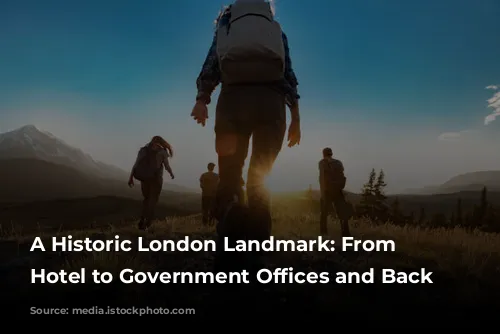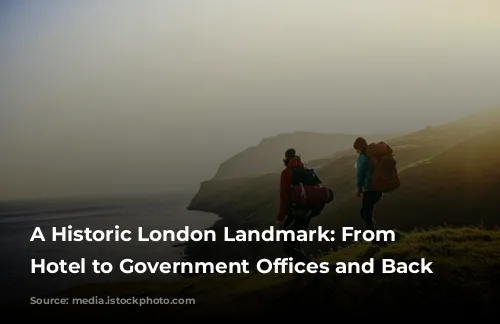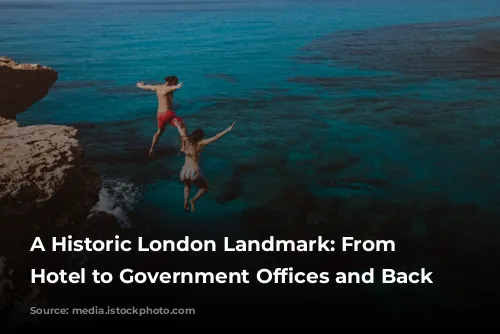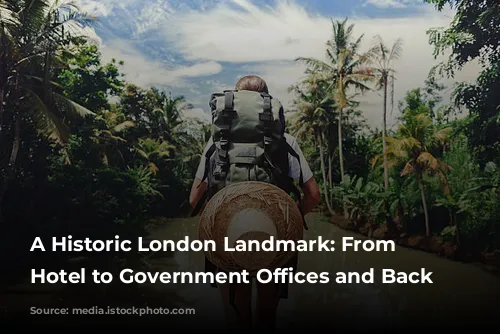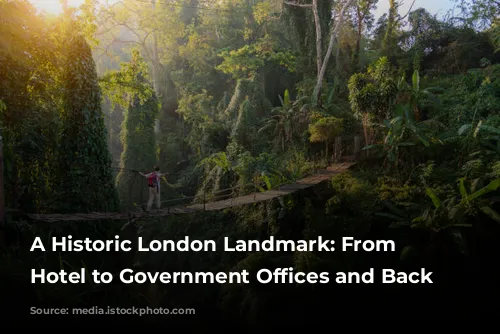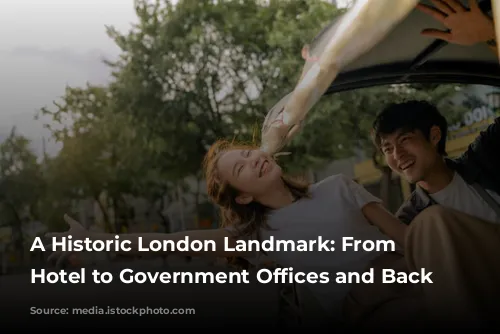Nestled in the heart of London, at the intersection of Northumberland Avenue and Whitehall Place, stands the Corinthia Hotel, a building with a rich history. Initially opened in 1885 as the Metropole Hotel, its prime location near the Palace of Westminster and government offices in Whitehall made it a popular destination. However, during both World Wars, the hotel was commandeered for government use, reflecting its strategic importance. After World War II, it was acquired by the Ministry of Defence, serving as government offices for over half a century, before being declared surplus and sold in 2007.
The Metropole Hotel, built by the Gordon Hotels company, quickly gained recognition for its luxurious amenities and elegant ambiance. The hotel was a popular gathering place for high society, hosting the annual dinners of the Aero Club and the Alpine Club. Even the Prince of Wales, later King Edward VII, frequented the hotel, reserving a special box in the ballroom and enjoying the Royal Suite, believed to be the first-floor rooms overlooking Whitehall Place.
The Metropole’s Role in World Wars
As war loomed, the Metropole Hotel, like many other buildings in the area, was requisitioned to provide accommodation for government staff. During World War I, it served as a temporary home for government officials, including the two Commanders-in-Chief, Field Marshals John French and Douglas Haig, the night before the British Expeditionary Force embarked for France.
After World War I, the Metropole reopened as a hotel and became known for its “Midnight Follies” cabaret, a popular entertainment venue. Bert Firman, a young violinist, was given the opportunity to lead the Midnight Follies Orchestra at the age of sixteen, making him one of the youngest band leaders in the world. In the years following the war, other notable band leaders, including Mantovani, performed at the hotel.
In 1936, the Metropole was once again caught up in historical events. The England Rugby Union team, led by Russian Prince Alexander Obolensky, defeated the touring New Zealand All Blacks in a historic match, a victory that cemented Obolensky’s place in rugby legend. The England team celebrated their victory at the Metropole Hotel, sharing the building with the defeated New Zealand team.
From Hotel to Government Offices: A New Chapter
In the mid-1930s, the government leased the entire Metropole Hotel, using it as alternative office accommodation. The Ministry of Labour and the Ministry of Transport were the initial occupants, followed by the Air Ministry and the Ministry of Defence. The hotel served as a vital government complex, housing various departments and playing a crucial role in wartime planning.
During World War II, the Metropole was requisitioned once again, becoming a temporary home for different departments. Room 424 was the first home for MI9, a British intelligence agency, and its sub-division, the Special Operations Executive. The hotel also served as a holding point for one of the model planning beaches for Operation Overlord, the Allied invasion of Normandy.

The Metropole as a Government Building: A Long Tenure
After the war, the Metropole Hotel was purchased by the Gordon Hotels company and transferred to the Crown Estate portfolio. The Ministry of Defence took control of the building, using it as an extension of its Whitehall complex. In the 1960s, the building became the primary location for the Defence Intelligence Staff, the remainder of the analysts and the central staff being located in the MoD Main Building. The Metropole building, depicted as MI6 headquarters in the James Bond comic strip, was also used by the Ministry of Defence for press conferences and other major events during renovations.

Returning to its Roots: The Corinthia Hotel
In 2007, the Metropole building and its neighboring building, 10 Whitehall Place, were purchased by a consortium led by Malta’s IHI plc. After extensive renovations, the building reopened in 2011 as the Corinthia Hotel, a combination of hotel and residential complex. The hotel’s transformation marked a return to its original purpose, showcasing its elegant architecture and rich history.
The Corinthia Hotel continues to be a prominent landmark in London, attracting guests and film crews alike. The hotel served as the location for the official announcement of the James Bond movie “Skyfall” and was also featured in the 2018 thriller “Red Sparrow,” further solidifying its place in popular culture.
The Corinthia Hotel stands as a testament to London’s history, its grand architecture and storied past reflecting the city’s evolution over the years. From a luxurious hotel to a vital government building, the Corinthia Hotel has played a unique role in London’s story, capturing the spirit of the times and embracing its rich heritage.
